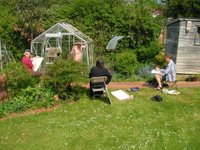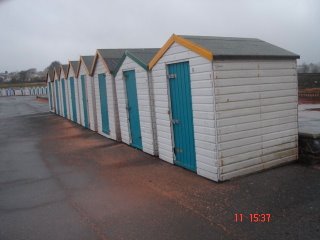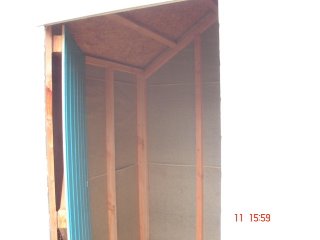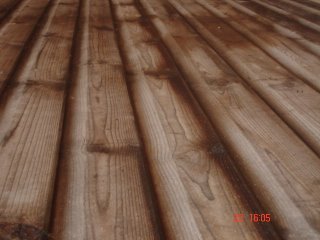
The Roundhouse event was our final 'Naked Shed' happening. The actual space was larger but inside we created a paper shed for the model to sit in or interact with. Again we didn't have a particular set of guidelines as to what we were going to do since we wanted the experience to be organic, to unfold during the event.
Questions from Male Model to Female ModelQ: Did this shed feel any different to model in as opposed to the Dartington shed, and if so how?
A: Yes it felt very different in many ways;
The venue was enclosed so that was different, though I was aware of outside noises like bird song as were several of the artists who commented on how quiet and peaceful it was. There were also a couple of funny moments when the ducks could be heard quacking outside as they came into land. How did the peace and quiet affect the situation?
Q: Do you think the experience would have been significantly different if you hadn't known the artists involved?
A: Yes I think it probably would have. Although I didn't know all the artists I knew most. A strong rapport has been built up between us and I'm sure that made the whole experience more comfortable. Whereas more adult issues of voyeurism etc came up in the last session, in this session, childlike issues such as fantasy and play arose also. When I stuck my foot through the paper shed the shadows created reminded me of Aurelia's "Oratorio" http://www.glennmeads.co.uk/archive/aurelias.htm
Q: Did undressing in front of the artists feel comfortable?
A: To be honest, I'd almost forgotten I had so yes I suppose! I undressed within the paper shed so was very unconscious and protected in my paper space.
Q: Were you conscious of artists peering through the holes in the tent? If so, how did they make you feel?
A: At one point I felt aware of an eye staring down at me and couldn't resist the urge to turn round and have a look. I knew the artist well and seeing only her eye peering down at me made me laugh out loud again raising questions such as "How funny can life drawing be?" And "Is it only experimental life drawing that creates such humour?"
Q: Did the shadows on the tent create any particular feelings, and if so what?
A: Yes as I mentioned before, the shadows took me back to a feeling of childhood, a place where magic and mystery becomes alive. The shadows changed the shapes making things appear bigger than they really were. When I poked my foot through the shed the shadow created on the paper was that of a huge foot that made many of us giggle. I guess then it's impossible to draw things how they're supposed to look because the shadow has distorted the image so much.

Q: Did you consciously choose poses to suit the circumstances?
A: I did with the "foot" pose. At another point I decided to pull on the dowelling that was holding the shed up. I felt like I was interacting with the paper venue. The venue gave me a context in which to pose, a medium to bounce off.
Q: Do you think the session forced the artists to consider drawing in a way that they would not normally have done if the tent had not been there?
A: Yes maybe not "forced" but "encouraged" though. I did observe at several points that the artists were all standing up whereas in the "usual" setting many are sitting down. Such liveliness and hilarity must have an effect on the drawing. It would be interesting to find out.
Q: Do you feel the artists were comfortable with the session?
A: Yes although I did observe one artist becoming frustrated that she could not see the whole figure and I was secretly hoping that she might so and rip the shed down!
Q: Were you any more self-conscious of your body in this session as opposed to other sessions?
A: No I was a lot less self conscious which I think comes from knowing the artists as well as being in an enclosed space.
Q: Did the fact that the artists were that much closer than a standard life drawing session make you feel any different?
A: It felt safe and cosy.
Q: Did you feel enclosed within the tent, or did the closeness of the artists nullify the effect of the tent?
A: No, I still felt enclosed within the tent but later on I did fell an urge to break free and escape. So I pulled more heavily on the catgut that held up the shed. Perhaps that is why I also chose to burn the paper shed at the end of the session so I could symbolically break free of the confines of my own limitations. Does the shed represent those limitations? I think in certain ways, yes it does.
Q: Did drawing a part of you in details, i.e. your foot, make you feel any different, and if so how?
A: Yes as explained before, it made things different and amusing. I think some of it I just did for laughs and some of it just because it seemed an obvious way to interact with the shed.
Q: Did not being able to see the artists at all times make you feel any different?
A: Yes but again in a playful way. Almost like I was playing a game of hide and seek.
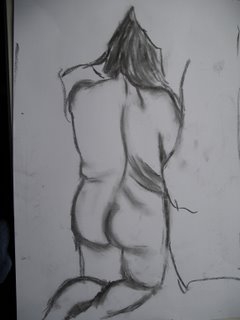
Q: Have the four sessions changed your view of life drawing, and if so how?
A: Yes I think experimental life drawing in terms of venue and medium is useful and fun. It helps both artist and model to explore new avenues of perception and break free of the expected mould.
Q: Have the four sessions made you feel any more confident
1) as a person?
A: I was very aware, certainly in the Devon sheds of how much freer I felt in myself in general.
2) with your body?
A: Yes I notice how generally unselfconscious I feel in a life drawing session but I still feel apprehensive about walking down the beach in a bikini.
Q: Has this project made you want to explore life modelling further?
A: I'd like to play more in modelling and set up events that might encourage that.
Q: Do you feel that working collaboratively has created more outcomes/questions than if you had worked singularly?
A: Yes, I know I'm full of ideas but working with someone who is a much better organiser and instigator than I am helps me to see those ideas acted out. And to me experience seems the best way of really finding out about things.
Q: Do you feel there are different questions that need asking from a male viewpoint, as apposed to a female one, as a result of this project?
A: I'm sure there are many questions that need asking from both viewpoints. I believe all sorts of assumptions are made but to get away from these assumptions we need to ask open-ended questions that don't lead those questions toward any kind of response. Over the sessions I have heard a number of artists, both male and female express their preference of drawing the female form. Is this the same everywhere and if so why? Is it just because of fashion? Had these sessions been done in Greek times would the preference have been the same?
Q: During this project, have you felt the object of voyeurism any more than during a more orthodox drawing session, and if so when?
A: No, no more than usual! In that I mean these questions do arise from time to time in life drawing sessions and these events have given us an arena to explore these issues that are usually not mentioned.
Q: Would you now say that you prefer to model outside the conventional "white cube" as a result of this project, and if so why?
A: Yes because it's more fun, more artistic and more things can happen. Boundaries of perception are pushed further and I feel encouraged to think outside the envelope therefore moving away from concept and deeper into experience.
Q: Do you have any other facets of life drawing that you feel need investigating as a direct result of this project?
A: For me this project has re kindled my love of life drawing and I would like to take this love into more and more public domains namely because I like art in the public domain as well as in the gallery. I like art that challenges perceptions and shakes up viewpoints. Therefore I would certainly like to set up more life drawing outdoors and challenge perceptions that somehow nudity endangers our children and should be discouraged.
Q: Would you have undertaken this project had it not been for the ACM module, and now that you have, are you pleased that the situation arose?
A: I think that I wouldn't have undertaken this project had it not been for this ACM module. The module has given me a reason and a deadline to enact my ideas. I found this to be very helpful.
Q: Do you think the amount of time/money invested in the project has been cost effective in achieving our desired results?
A: To me a shed is a very homely object. I wanted to keep the project within that arena. So cost has not been a huge aspect of this project so in that sense it has been very cost effective financially. Instead of hiring venues, venues were loaned in exchange for cakes! Also perhaps because were artists, the beach hut was "given" to us for the day. And although the artists in the Hebden Bridge venue paid (though they didn't have to), that money went to the long standing drawing group and covered venue costs such as coal and electricity.
As for the time invested, I think it was all well worth it.
Q: In retrospect, would you have undertaken the project any differently?
A: No I don't think so because it is the experience of this unique event that has lead me to where I am now. Had I undertaken the project any differently I may not have ended up in the same place.
Q: Do you believe that a male/female perspective was essential in the project?
A: No, I don't think it was essential but I think it has provided us with several interesting questions and an arena for further study i.e. What would this project be for a transsexual model?
Q: Any other comments?
A: Soon!!!
Questions from Female Model to Male ModelQ: This was the first completely enclosed environment. Did this influence you experience in any way. If so, how?
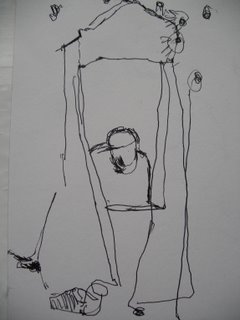
A: As the artists were friends of yours already I also felt as if I knew them. This probably did have an influence on my experience. Because it was an enclosed space, and an intimate one, I felt as if I was one of the group, and therefore felt quite at ease.
Q: Did you feel like the paper shed was your own personal space or did it belong to the whole group?
A: I felt as if I was in control of the paper shed, and it was indeed my space. The fact that artists could peer into it did feel strange, as if they were invading my space.
Q: Describe your observations of the artists in response to the paper shed in terms of
atmosphere.

A: The artists as regards behaviour seemed no different to a normal session. If you mean my observations visually, i.e. as a result of looking at them, I didn't consciously look at any artists. Being so close to them it didn't feel appropriate.
Q: Describe your experience of being looked at through a small hole?
A: It was a feeling I had never experienced before. Obviously in a normal life drawing session one is looked at and observed all the time, but no specific part of a model's anatomy is consciously drawn at such close proximity, or singled out for observation. This did feel very strange, irrespective of the part of me being drawn. This I feel was the nearest I have got to feeling that a drawing session was in some way erotic as well as artistic.
Q: Describe the effects the shadows had on your experience and detail any questions raised?
A: Because the shadows were sometimes very sharp, the artist was obviously very close, consequently this felt very strange. Also, I didn't know who was the other side of the paper, and not knowing who the artist was is something that never normally happens in a life class. I wouldn't have said that I felt uncomfortable with the situation, more so excited, though I think this is because it was a new experience rather than for any other reason.
Q: Did any issues of gender arise/not arise?
A: As there was only one male, it isn't easy to answer that question. The fact that so many women were that close as apposed to men probably does raise questions, though what I can't say for the reason stated.
Q: Did any issues of familiarity arise/not arise?
A: Not sure I understand the question. The whole session was a life class, so the basic rules and modes of etiquette that normally apply did so in this case, though if the session had not been planned as an investigation into space within a life drawing context, the rules would certainly have been bent, if not broken.
Q: Did this experience push the boundaries of conventional life drawing in your opinion and if so how?
A: Yes, definitely. The closeness of the artists was very different in this situation as apposed to the beach hut, where I was fully aware of all the artistÂs movements, from hand movements to eye movements. Not knowing where the artists were, and also not knowing what they were drawing, was very unconventional. Inviting an artist to a life drawing session is an open invitation to observe and draw your body, but drawing a part of a body from close range as apposed to the whole body from a distance then pushes the boundaries of drawing further towards an anatomical observation as apposed to an artistic one.












